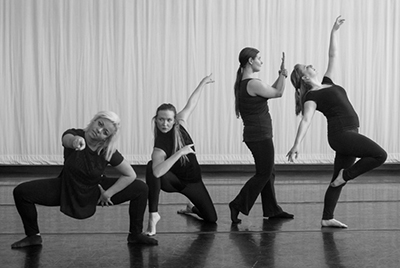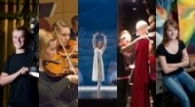Student Engagement Forum to host Student Choreography Showcase

Dance students present the annual Student Choreography Showcase as part of the Student Engagement Forum Monday and Tuesday, April 25 and 26. The Office of Undergraduate Research and Scholarship (OURS) is the host of this campus-wide week of events.
The performances are described as “An evening of exploratory dance, Student Choreography Showcase highlights the voices of emerging choreographers enrolled in the Department of Dance's Choreographic Studies II class.” Deborah McLaughlin is the students' faculty mentor.
Participating students include Hollis Bourne-Frye, Alexa Dunks, Amy Livesa and Kaitlin Tormey.
For the forum, each student choreographer describes her work:
Hollis Bourne-Frye – My choreographic process as an artist undergoes a complex power-struggle between heart and mind. It can take many different twists and turns throughout the creation phase that then develops into a vivid waterfall effect of storytelling. When first exploring where I want a piece to go I start with an idea and allow it to then take its form. Next I add a dash of detail and a sprinkle of rhythmic accompaniment to help elaborate the message I'm trying to get across for each particular piece. As each artist knows, once you allow the piece to take shape (either on yourself or your dancers) it then has a mind of its own that can expand into brilliance or collapse into disarray. When this happens, the choreographer must help the piece to find where it belongs again and provide guidance to getting back on its feet through use of various visual aids (such as lighting, costuming, sound design, etc.). I also find that every piece I've created starts in their own way, which brings an energy to the artistic process as if each piece is then born or created. The choreography behind my solo piece, “I am...,” is to express my pain and growth of developing as a mixed race citizen in our society. The props used within the piece express the negative stereotypes that come with being seen as one race OR the other, whereas I view and wish for others to see myself as I am. I found the process to be a little more difficult when dealing with choreographing the group piece, “Diverse Ideologies: Logical, Mechanical, & Emotional.” This has to do with its complexly articulate use of details through the use of individual rhythmic coordination among each dancer depicting different mechanisms that define the insides of a machine. They also represent the general structure of human anatomy and how certain movements affect the body. In relation to this concept, I am also comparing and contrasting three vastly different ideologies to find unity between them. The piece overall reflects how my thought process has evolved over the course of my four years at Radford University exploring a diverse range of conceptual ideas and bringing them together.
Alexa Dunks – My choreography was built from personal experiences and observations that I have witnessed. When choreographing, I usually base my dances off of true stories that the audience can relate to. In this performance, I wanted to relate my choreography to my family because they are the reason I am so driven to succeed. I will be presenting two group pieces that focus on utilizing dynamics as well as playing with emotions. “Road to Recovery” is a dark piece that informs the audience about the seriousness of addiction. Throughout this dance, the movement tells a story about the process of recovery. “Esperanza” contains intricate movement, partner work, and juxtapositions of extreme tempo changes. The sound score of this piece includes a poem written by the recovering addict. My work also includes an autobiographical solo, “The Blind Spot,” focusing on personal issues that one of my family members and I share. Through the movement, I hope the audience will be able to relate to the pieces and be moved in an emotional way.
Amy Livesay – My choreography overall is meant to be direct. Every movement, gesture or detail has a purpose, meaning, and place in telling the underlying story for those watching. My group piece, “Deciding Factor,” utilizes a quote; “you are not a product of your circumstances, you are a product of your decisions” that informs the work. The music is not influencing the five dancers, but rather giving them sound to work through their conceptual exploration of the poetic phrase. My solo, “Not Forgotten,” explores the constant struggle between memories of the good times and bad. This piece primarily explores the emotions from losing a close friend in a car accident the winter of my sophomore year of high school. My main focus for this piece is to challenge myself expressively through the choreography and to b e vulnerable in connecting with the audience on a universal level. Paying attention to the details like a hand gesture or facial expression is important for me because this piece is deeply emotional.
Kaitlin Tormey: “Behind the Smile” – A choreographer chooses what to show, but the audience chooses what to see. My choreography reflects my own experience, knowledge, and emotions. The focus of my creative work is usually the issues in society and the individual as well as the deeper, darker, and more serious human emotions. According to psychologist Johann Herbart, the mind is a battleground. “Behind the Smile” focuses on this battleground and the pain and struggle hidden behind the smile we wear when others are around. In “Behind the Smile,” I chose a jacket to symbolize the part of us that we show to others. I also explored how detailed movement of the hand and gestures could be used to help portray the conflict.
The Student Choreography Showcase is at 7:30 p.m., April 25 and 26 at the Albig Studio Theatre, Peters Hall B112. Admission is free.
